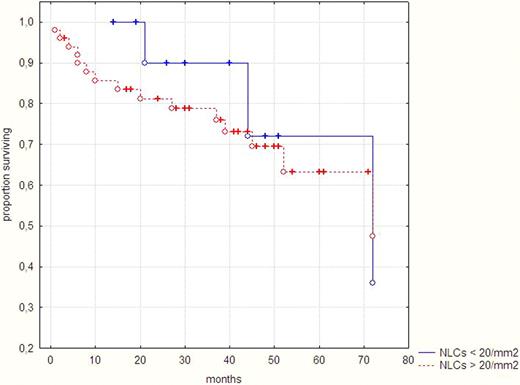Abstract
Abstract 2360
Poster Board II-337
Despite their longevity in vivo, CLL lymphocytes die rapidly when put to in vitro cultures, what proves that the resistance to apoptosis is not an intrinsic feature of leukemic cells, but depends on environmental signals. Recently it was shown that mononuclear cells from peripheral blood of CLL patients differentiate in vitro into large, adherent cells that grow in close contact with CLL lymphocytes. They were termed “nurselike cells” (NLCs), because they support leukemic lymphocyte survival in culture. The presence of the cells morphologically and phenotypically similar to NLCs was demonstrated in peripheral lymphatic organs of CLL patients. It may suggest their role in CLL lymphocytes protection in vivo and, as a consequence, point the new target in CLL treatment.
The study included the group of 65 previously untreated CLL patients, 24 women and 41 men, aged from 36 to 86 yrs. 12 patients (18%) were diagnosed with stage 0 according to Rai, 15 patients (23%) with stage I, 30 patients (46%) with stage II, 5 patients (8%) with stage III and 3 patients (5%) with stage IV. Peripheral blood lymphocytes ex vivo were examined for CD14, CD38, BCL2 and ZAP70 expression by flow cytometry and for BCL2, SURVIVIN and ZAP70 gene expression by RT-PCR. TP53 gene status was assessed by FISH. Lymphocytes of 20 patients were assayed for apoptosis-related gene expression by means of cDNA macroarrays (Clontech). To generate NLCs, PB leukemic cells were cultured in vitro for 14 days on standard medium (RPMI 1640 with L-glutamine, 15% FCS, antibiotics/antimycotics; cell density 3 × 106/ml) and the outgrowth and number of NLCs was assessed in relation to clinical and hematological parameters. NLCs were identified morphologically and by CD31/VIMENTIN protein expression.
In 58 cases (89%) the outgrowth of NLCs was observed, while their number differed in cultures of the cells of different patients: in 49 cultures (84.5%) there were over 20 NLCs/mm2 (up to 52 NLCs/mm2), and in 9 cases (15.5%) less than 20 NLCs/mm2. Positive correlation was shown between NLC number and B2M serum level (p=0.044) and absolute monocyte count (p=0.019). Significantly higher NLC number was observed in case of patients with higher CD14+ cell number (p<0.0001) and higher SURVIVIN gene expression assessed by RT-PCR (p<0.0001) and macroarrays (p=0.013). We found no statistically significant relation of NLCs number and: the Rai stage of the disease, WBC, lymphocyte count, LDH serum level, BCL2, CD38 and ZAP70 expression and TP53 gene status. During the follow-up period of 6 years we observed the tendency for longer overall survival in patients that produce less than 20 NLCs/mm2 (fig. 1), but it was not statistically significant.
The number of NLC cells obtained in vitro from PBL of CLL patients correlates with B2M serum level and SURVIVIN gene expression in CLL cells ex vivo. High B2M level is a marker of poor prognosis. SURVIVIN represents a family of IAP (Inhibitor of APoptosis) proteins. While rare in PBL of CLL patients, its expression is typical for proliferating leukemic cells pool in pseudofollicle microenvironment. SURVIVIN inhibits apoptosis by blocking caspase-3 and -7. Considering the protective role of NLC cells towards CLL lymphocytes in vitro, these results altogether with observed tendency to shorter survival of patients generating high NLCs number may prove the presence of supportive mechanisms exerted by NLCs in vivo.
No relevant conflicts of interest to declare.
Author notes
Asterisk with author names denotes non-ASH members.


This feature is available to Subscribers Only
Sign In or Create an Account Close Modal